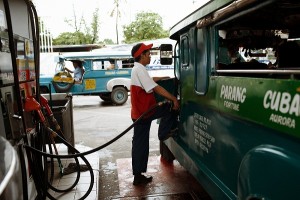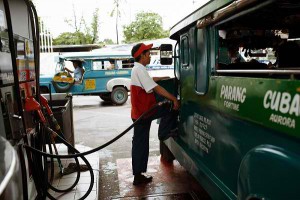By KATHLYN DELA CRUZ

IF the gauge of a successful information campaign is awareness of its target beneficiaries, the government’s media group appears to have bungled its job once again.
A month after the government started distributing fuel cards to the public transport sector on May 2, many jeepney drivers have still not availed themselves of the subsidy simply because they were not aware of it.
The Philippine Information Agency has been tasked to coordinate with local governments in informing the drivers about Executive Order No. 32, or the Pantawid Pasada Program, issued by President Benigno Aquino III on April 1.
The program aims to provide the public transport sector fuel assistance to help them cope with increasing oil prices. The Department of Energy is distributing fuel cards loaded with P1,050, which can be used by a jeepney driver to purchase diesel from certain gasoline stations.
“Ano ba ‘yun? Bago lang ba ‘yun (What’s that? Is that new)?” Sergio Pigaro reacted when asked to comment on the government’s fuel subsidy.
Pigaro, 53, a jeepney driver for 22 years, spends P1,000 for gasoline. He only earns P300 to P400 a day since he gives the rest of his earnings to the jeepney owner as boundary fee.
Under the boundary system, the driver has to pay the owner of the jeepney a pre-agreed amount for daily rental fee (usually P500).
Apil Gabino, a driver in Bicutan, said: “Nabalitaan ko lang sa kapitbahay namin, tulong daw ng gobyerno. Totoo pala ‘yun (I just heard of it (fuel subsidy) from our neighbor? It’s supposed to be assistance from the government. So, it’s for real?)”
Gabino started working as a jeepney driver in 1995. He budgets his P400 daily earnings to support his wife and three kids.
Drivers of jeepneys traversing Bicutan were scheduled to redeem their fuel cards on May 9, but Gabino still hopes he could be given a fuel card to assist him with his P1,000 daily expense for gasoline.
Noriel Maranan, a 29-year-old jeepney driver, plies the Katipunan-University of the Philippines Diliman (UPD) campus route from 6 a.m. to 8 p.m. five days a week.
Maranan, a jeepney driver since he was 18, spends P900 for gasoline a day. He takes home only P900 to P1,000 after deducting the amount paid for jeepney rental. He has three kids, two of them incoming kinder and prep students this June. Whatever he earns as a driver is his family’s only source of income.
Also plying the same Katipunan-UPD route is 64-year-old Virgilio Abejar, who has been a jeepney driver since 1973. He was able to send his two children to college with the help of his wife, a public school teacher for 20 years who resigned after being diagnosed with aneurysm–an abnormal widening of an artery due to weakness of a blood vessel.
Abejar spends at least P500 for gasoline for driving from 7 a.m. to 7 p.m. daily. He earns P1,200 to P1,300 a day—more than what Maranan earns since Abejar drives his own jeepney.
Jeepney drivers like Abejar whose routes originate from Katipunan were scheduled to get their fuel cards in May.
Abejar said he has just heard about the program when a gasoline station personnel asked him why he was not using his fuel card. Likewise, Maranan said he only heard of it from his co-drivers but they, too, were not able to get fuel cards.
Celederio Rubeso, a 54-year-old jeepney driver in BF Homes Parañaque, has also been relying on his earnings to support his nine children since 1978. He is able to take home an average of P800, only 40 percent of his daily earnings. He spends P1,100 for gasoline per day while the rest goes to the jeepney owner.
Despite his low income, two of his four children were able to finish vocational courses. The other two are now in high school.
Maranan, Abejar, Pigaro, Gabino and Rubeso are among the many drivers who had failed to redeem their fuel cards being unaware of the Pantawid Pasada Program.
To be a program beneficiary, a driver is required to submit to the Land Transportation Franchising and Regulatory Board the original franchise certificate, official receipt or certificate of registration of the jeepney and two valid identification cards.
Of the P450 million fuel assistance allocated for the Public Transport Assistance Program, P300 million is allotted for jeepney drivers and P150 million for tricycle drivers.
Those who had missed the deadline for availing of the fuel cards hope they could still be given this government subsidy, especially now that earning enough has never been this hard.
(The author is a University of the Philippines student who did her summer internship at Vera Files.)
